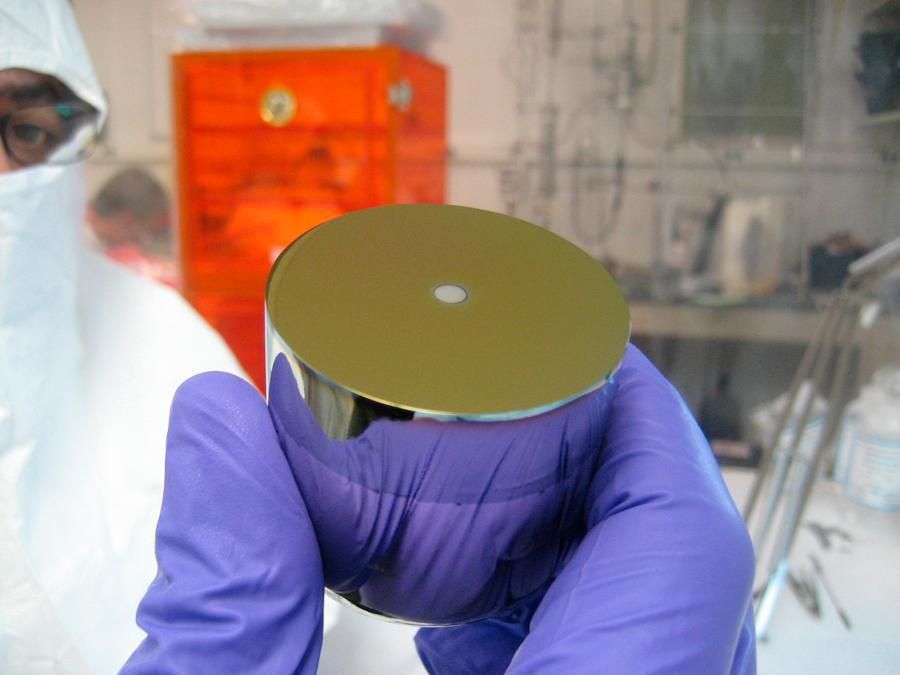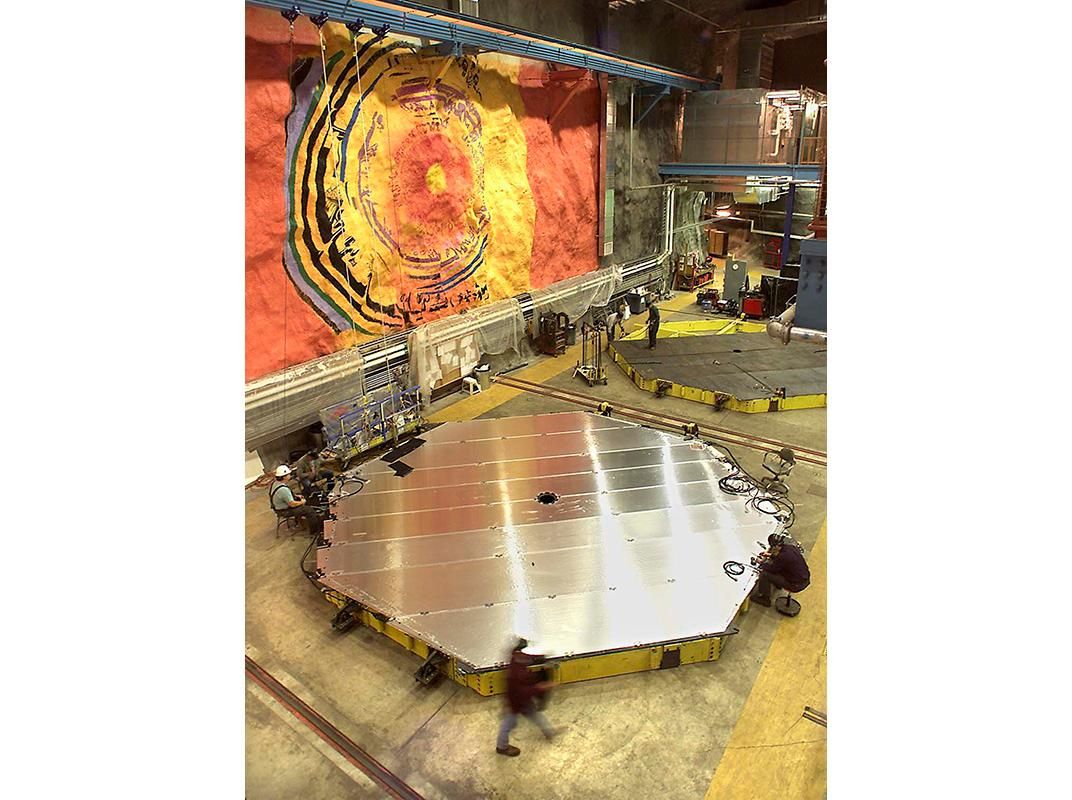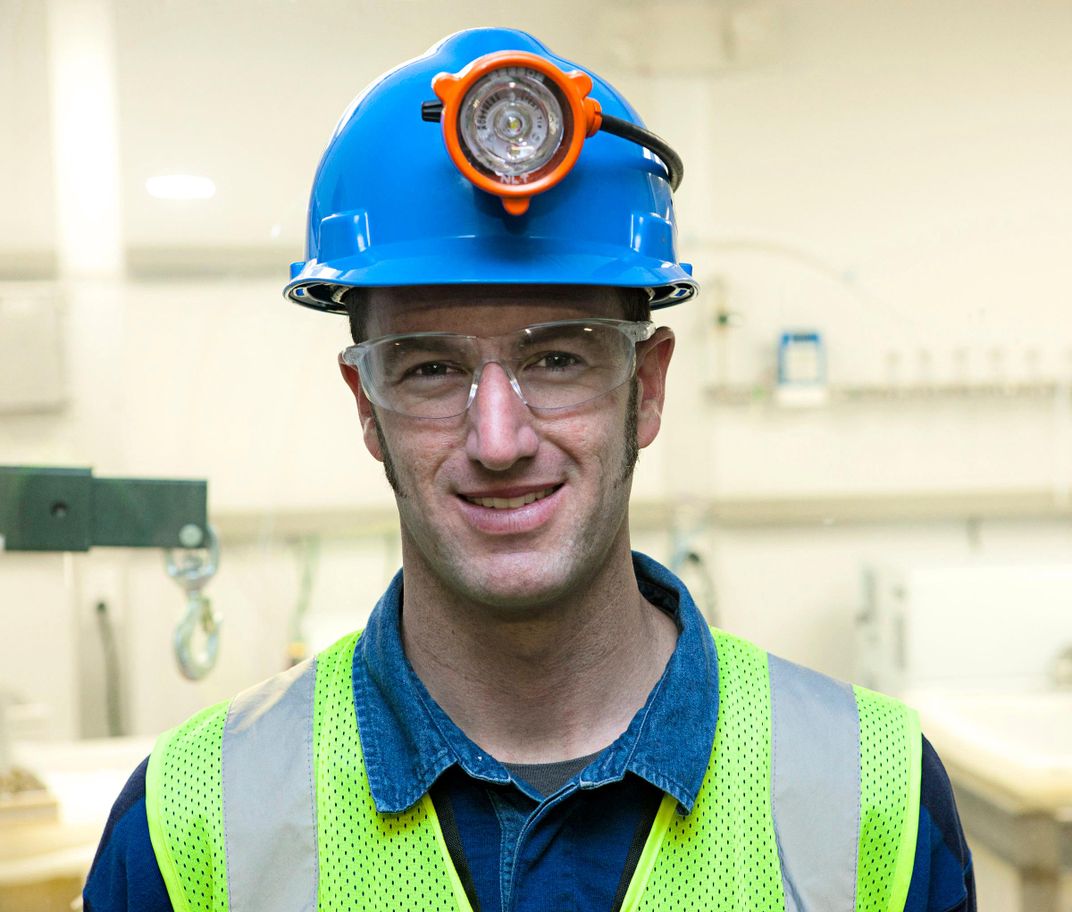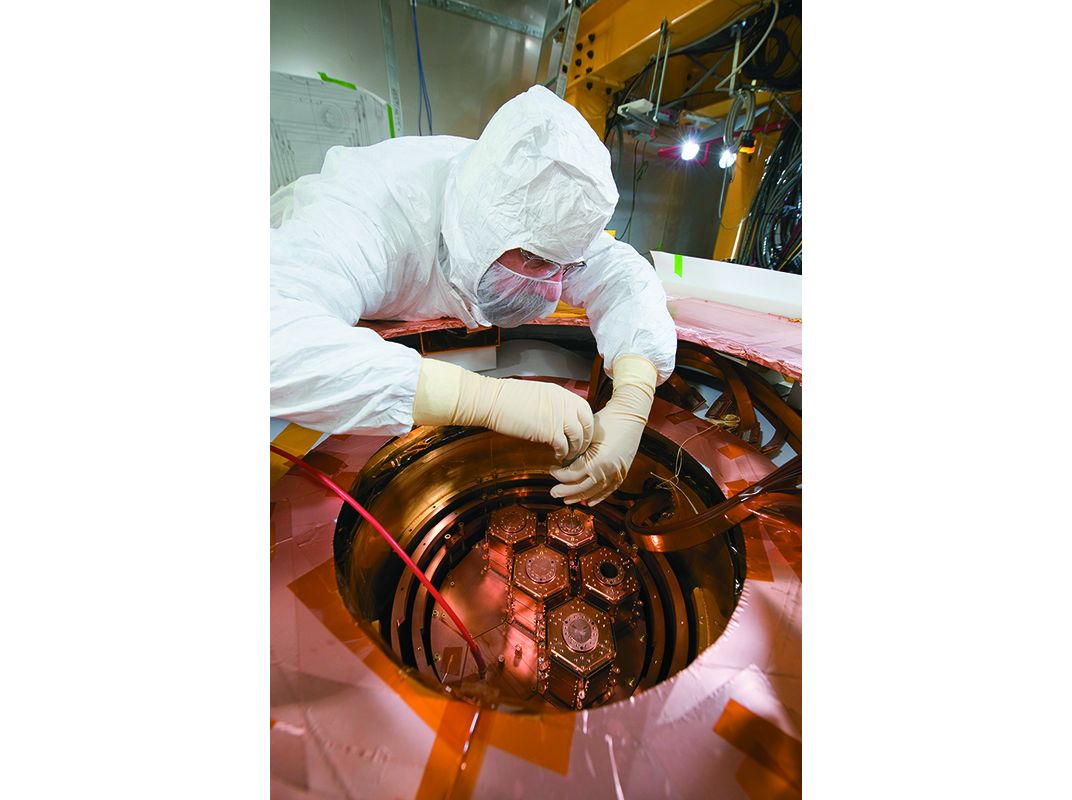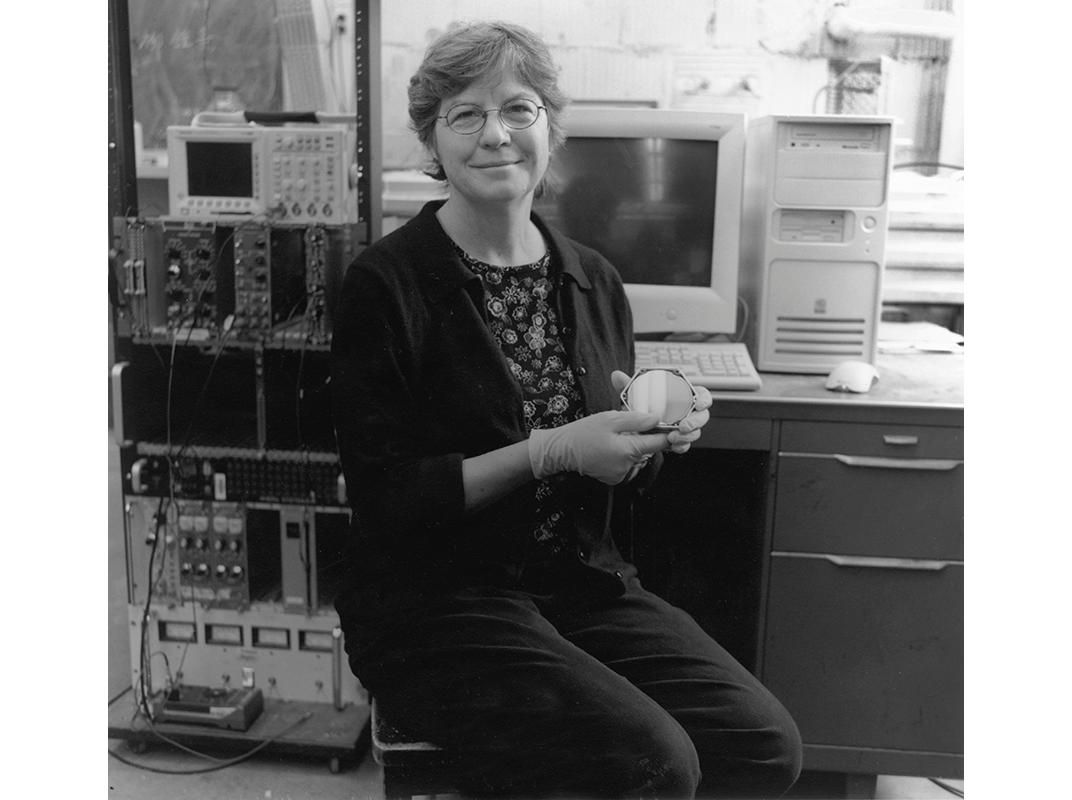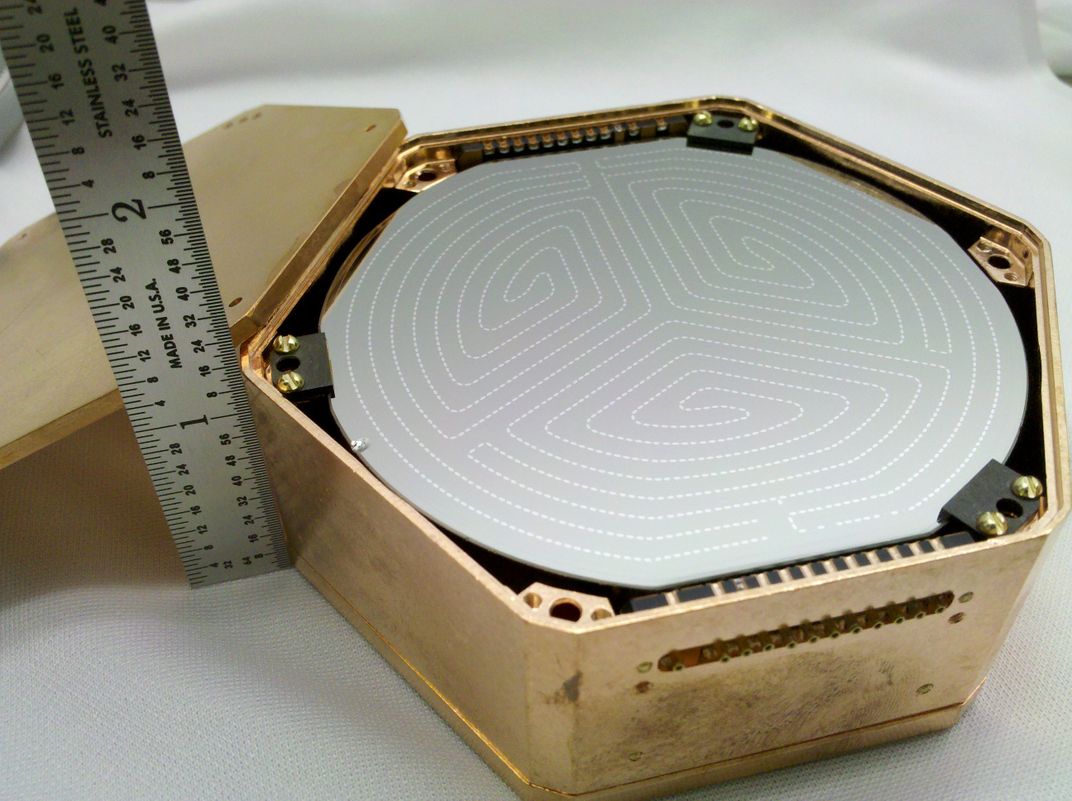Dark Matter Detectives
The hunt for the most elusive particles in the universe is half a mile underground.
/https://tf-cmsv2-smithsonianmag-media.s3.amazonaws.com/filer/d1/97/d197adb5-debe-4a19-b945-331d7fd006ca/02d__dj2015_soudanminosmural_live.jpg)
As Peter Redl and a colleague prepare to enter the clean room that houses the Cryogenic Dark Matter Search detectors, they take the usual precautions. Blue bunny suits? Check. Caps and booties? Check. Electronic gizmos? Left in the office. Bananas? Nowhere in sight. “If you put a banana next to the detectors, the radioactive decay of the potassium will cause about 2,000 events per minute,” explains Redl, a postdoctoral researcher at Stanford University. “So we’re not allowed to eat bananas.” When you’re searching for the most bashful of cosmic particles, you can’t be too careful.
Although no one has ever seen it, dark matter appears to be roughly five times as abundant in the universe as normal matter, and the leading theory says it consists of subatomic particles. Yet despite some tantalizing hints that have emerged from at least a dozen experiments conducted since 1987, there are still no confirmed detections of such particles.
In early 2014, scientists at the Soudan Underground Laboratory—a center in northeastern Minnesota where more than a dozen universities and three national laboratories in the United States and Europe conduct experiments—thought they had finally seen dark matter: The Minnesota detectors correlated findings with those from an experiment in Italy. It turned out to be a false alarm, but the study and other projects have helped to give scientists a better idea of how to refine their search.
Because dark matter particles almost never interact with the “normal” matter that makes up stars, planets, and everything else we can see or touch, they’re difficult to detect. Moreover, the effect of an encounter is so slight that the collision is easily drowned out by the cacophony of everyday radiation. It’s a bit like trying to detect the buzz of a mosquito at a Metallica concert.
“The name of the game is to try to detect dark matter particles and not fool yourself with other signals,” says Dan Bauer, project scientist for Cryogenic Dark Matter Search (CDMS), one of Soudan’s two dark matter experiments. Bauer works at Fermilab, a Batavia, Illinois research center that directs CDMS. “Dark matter isn’t the only thing coming to us from space: We get cosmic rays, and some of them penetrate down to ground level. That’s a horrible background for dark matter detectors.”
To avoid the jamming effect of cosmic rays, the world’s banana supply, and various other radiation sources, the dark matter detectors are protected by a Faraday cage—an enclosure that prevents electrical current from flowing through the space it surrounds—as well as lead blocks and other shields. Most important, it sits almost half a mile beneath the tree-covered landscape of Minnesota’s Soudan Underground Mine State Park. The Soudan laboratory is an extension of a former iron mine. Overlying layers of Ely greenstone block most of the cosmic rays that bombard Earth’s surface.
The volcanic rock protects more than just the search for dark matter. The Soudan laboratory hosts several experiments that require a radiation-quiet environment. A cabinet that resembles a large commercial oven, for example, houses semiconductor materials; researchers will compare the radiation-shielded semiconductors to identical chips exposed to the relatively radiation-rich environment at high altitudes. Soudan’s largest experiment—6,000 tons of iron plate described by participants as a battleship in a bottle—catches the particles known as neutrinos, which are byproducts of the nuclear reactions in the hearts of stars.
The dark matter experiments are designed to expand the scientific understanding of the birth and evolution of the universe, and to fill in the gaps in physicists’ basic framework of how matter and energy work: the Standard Model.
The Standard Model splits the universe into two kinds of particles: particles of matter, such as the electrons and the building blocks of protons and neutrons, which make up atoms; and particles known as force carriers. Photons—particles of electromagnetic energy—belong to the latter category. The Standard Model has not yet been able to incorporate dark matter. Yet dark matter must exist, because scientists see evidence of it almost everywhere: in the motions of the stars, in the existence of galaxy clusters, in the clumpiness of the early universe.
“We know from all sorts of different observations of the universe that either dark matter exists, or we’re wrong about gravity,” says Fermilab’s Dan Bauer.
At Soudan, the search continues. “We’re looking for things that go beyond the Standard Model,” says John Orrell, co-leader of Soudan’s other dark matter search, the Coherent Germanium Neutrino Technology (CoGeNT) experiment.
Down in the Mines
At 7:30 on a snowy spring morning, staff members and visiting scientists meet Jerry Meier, Soudan’s lab supervisor, at the mineshaft’s headframe, an open steel tower that resembles an old Cape Canaveral gantry. It supports a small elevator car, “the cage,” which originally carried miners deep into the earth.
After a clattering three-minute ride in total darkness, the door opens to reveal an engraved metal sign:
Level No. 27
2341 Feet Below The Surface
689 Feet Below Sea Level
The CoGeNT “office” looks like a cross between an industrial warehouse and the Batcave. Off to the left, carts like the ones from Indiana Jones and the Temple of Doom wait to take tourists into the dark tunnel that once led to the mine. But turn right, follow a curving hallway, and pass through a swinging door, and it’s a scene from a different movie: Two caverns excavated for the laboratory are filled with offices, racks of electronic equipment, stacks of aluminum tubes, machine shops, a soft drink machine, and the kind of bric-a-brac you’d find in any warehouse. But the dewars of liquid helium and nitrogen, the rows of computer monitors, and the flashing red lights warning pacemaker wearers to STAY BACK might have you thinking you’ve stumbled into a James Bond villain’s secret lair.
“It’s a unique place to work,” says Meier, who joined the lab 25 years ago. “Since we’re underground, there are some challenges. Everything you bring down has to go back up. There’s no potable water—we have to bring down bottles. We train for mine rescue operations, we even train people on what to do if a bat lands on you.” (Screaming isn’t on the list.)
The hunt for precious and elusive material was made possible by the prospectors of 130 years earlier, who discovered gold in the hills of the Vermilion Range, about 200 miles north of Minneapolis–St. Paul. But it was scarce and difficult to extract, and the gold rush fizzled.
Miners discovered rich veins of iron, however, excavating the first ore from the site in 1882. U.S. Steel took over the mine in the early 1900s, eventually sinking 17 shafts and honeycombing the hills with more than 50 miles of tunnels, or “drifts.” The mine shut down in 1962 when it became more profitable to strip-mine lower-quality ore in other parts of the state than to excavate it from deep below the surface. U.S. Steel then donated the mine to the state of Minnesota.
University of Minnesota physicist Marvin L. Marshak toured the mine while on vacation in the mid-1970s and remembered the place when he began pondering a new physics problem a few years later.As part of their efforts to unite all the basic forces of nature into a “theory of everything,” some physicists had predicted that a proton—the positively charged component of an atom’s nucleus—would eventually fall apart.
To study the problem, Marshak needed a deep hole in the ground, protected from cosmic rays, the high-energy protons and electrons constantly raining into Earth’s upper atmosphere from exploding stars and eruptions in distant galaxies. As one of these particles strikes atoms of oxygen, nitrogen, and other elements in the air, the impact starts a chain reaction that generates cascades of particles and energy that can flood electronic detectors, making it impossible to find a signal emitted by a decaying proton. That’s why physicists looking for rare-particle events place their experiments below the surface.
“I had been looking at mines in Colorado but I didn’t find anything, so I was getting depressed,” Marshak says, pulling a copy of his original proposal off a shelf in his office at the University of Minnesota in Minneapolis. “And my wife was upset that I was running around the U.S. looking at mines.” Marshak and his wife, Anita, had visited the Soudan site together. “She said, ‘Why don’t you go use that?’ ”
Marshak, who still directs the Soudan lab, called the park superintendent, who agreed to lease him space in an abandoned drift. The original proton decay experiment began in 1981 and ran for six years. When it ended, Marshak and colleagues built a bigger detector, Soudan 2, which operated until 2001 but didn’t see a single proton decay. Nor has any other detector in the years since. (More recent research has concluded that the lifespan of a proton must be longer than was believed when the proton decay experiments of the 1980s and ’90s were being designed, Marshak explains.)
By the time Soudan 2 concluded, however, physicists were beginning to search for the hypothetical particles known as dark matter.
Dark Matters
Evidence of dark matter appeared as early as the 1930s, when Swiss astronomer Fritz Zwicky, working at the California Institute of Technology, found that the thousands of galaxies in the Coma Cluster weren’t massive enough to hold the cluster together. He postulated that the galaxies were bound by a missing mass, for which he coined a term: “dark matter.” Various observations have demonstrated that this matter can’t be black holes, faint stars, hidden planets, or other large objects. The leading theory says it consists of WIMPs—Weakly Interacting Massive Particles.
According to the theory, these subatomic particles were created in the Big Bang. They’re much heavier than particles of normal matter, with estimates ranging from a few to a few thousand times the mass of a proton. They exert a gravitational pull on the visible matter around them, making it easy to see the effects of large aggregations of WIMPs, like the ones astronomers observe (via their gravitational effects)in galaxies and galaxy clusters.
Individual particles are difficult to detect, however, because they interact with normal matter only through the “weak” force, one of the fundamental forces of nature. (The other three are gravity, electromagnetism, and the strong force, which holds the nuclei of atoms together.) Although it is responsible for radioactive decay and other phenomena, the weak force is so puny it requires a WIMP to score a direct hit on an atomic nucleus—like a cue ball bumping into a clump of billiard balls—to produce any reaction at all. WIMP detectors all look for this tiny reaction, which could take the form of a slight increase in temperature, a change in electrical charge, or a spark of light.
Both of the Soudan dark matter experiments try to catch WIMPs with “hockey pucks” of ultra-pure germanium, which provide a big, heavy target for the dark matter particles. CoGeNT uses a single puck, whereas CDMS has 15 (an upgrade from the original experiment installed at Soudan in 2003). Instruments are etched into the detectors’ surfaces like transistors on a computer chip, allowing scientists to record any impacts within the crystal structures.
“If a dark matter particle comes in and hits the nucleus of a germanium atom, it causes the nucleus to recoil, heats the crystal, and produces a signal,” says University of Minnesota physicist Priscilla Cushman, a member of the CDMS team. “But the germanium nucleus is like a grape inside the Metrodome, while the electrons around it are the walls of the Metrodome. Everything else is empty space, so these encounters shouldn’t happen very often.”
Clean Air Act
Just because the detectors are deep below the surface doesn’t mean they’re completely isolated from radiation. “There are neutrons from the rock, radon in the air—all kinds of sources of radiation,” says University of Chicago physicist Juan Collar, founder of the CoGeNT experiment. “But we have a big bag of tricks to clean up the spectrum from known sources.”
CoGeNT sits in a truck-size cabinet at the back of the lab’s first cavern. A grid of instruments around the cabinet records and identifies strikes by neutrons and other heavy non-WIMP particles, allowing scientists to disregard those hits in the germanium detector. Inside that grid, an aluminum shell and a wall of lead bricks block much of the terrestrial radiation. Finally, to reduce vibrations from the germanium atoms themselves, the detector is placed in a thermos bottle of liquid nitrogen, which chills it to –321 degrees Fahrenheit.
In these conditions, the detector records minute electrical pulses caused by collisions between the germanium nuclei and any particles that have passed through the shielding, including WIMPs.
But there’s no flashing light or clanging alarm to alert a bored scientist that she’s just hit the scientific jackpot. The detectors record thousands of interactions between the detector material and subatomic particles. Those interactions all closely resemble one another, so researchers must conduct a long and painstakingly detailed analysis to winnow out the WIMP collisions from those of more mundane particles.
When CoGeNT detected a few signals in early 2014 that had also been seen by an Italian dark matter experiment, the scientists published a paper that reported the possible detection of WIMPs. A few months later, however, the scientists weren’t so sure. “We don’t know if what we’re seeing is real or not,” says Collar, using “real” to mean “of cosmological origin.” “There are a number of possibilities that aren’t related to dark matter.”
John Orrell of Pacific Northwest National Laboratory says the detections were at the limit of their experiment’s capabilities. When he compared his results to those of CDMS, which is only a few yards from CoGeNT, he concluded that the observations probably weren’t seeing WIMPs at all. “Our goal was to say, ‘Yes, we see an excess number of events’ or ‘Yes, all the events are due to the background radiation and systematic effects in the experiment,’ ” Orrell says. The analysis was inconclusive. “There was a lot of effort to make it one way or the other, but nature didn’t work out that way for us. It’s a very frustrating outcome.”
The Two Detectors
CDMS is like CoGeNT’s bigger, touchier, chillier cousin. It’s housed in a two-story, high-tech cocoon near the front of the cavern, surrounded by similar shielding but with a far more complicated refrigeration system—remember, “C” is for “cryogenic”—which uses liquid nitrogen and liquid helium to cool the detectors to a fraction of a degree above absolute zero (about –460 degrees Fahrenheit).
The colder detectors are designed to register not just the electrical pulses from dark matter impacts but also a small rise in temperature caused by the vibrations of a germanium nucleus recoiling after it’s smacked. This one-two combination provides a far more sensitive test for WIMP collisions than the more limited CoGeNT experiment. And as the cryogenic detector team reported in early 2014, it has yielded little evidence of dark matter.
“I wish we could say we’ve found dark matter, but I can’t,” says Bauer. “We had three events that looked like they might have the characteristics of a dark matter signal, but you need really convincing proof to claim a discovery, and we didn’t have it. And we’ve taken more data since then and we’ve shown that it wasn’t dark matter.”
Yet both of the Soudan experiments, along with the others being conducted around the world, have helped physicists narrow the range of WIMP masses. Particles at the heavy end of the range should have revealed themselves by now because they would produce a big thunk with a correspondingly large recoil by the detector material. The lack of confirmed detections suggests that if WIMPs exist, they are likely at the smaller end of the scale.
“The simplest theory isn’t working, which puts theory in tension with the experimental evidence,” says Cushman.
To try to ease that tension, both CoGeNT and CDMS researchers are planning upgrades to their experiments’ sensitivities. In 2015, the CoGeNT team will replace the current germanium detectors with two new ones that have a combined mass 10 times greater than the current one. “The best scenario is we turn on the new experiment and we instantly rule out more possibilities,” says Collar. “And if we see the same sort of anomaly, we can study it in more detail.”
The Cryogenic Dark Matter Search team, in the meantime, will receive funding from the Department of Energy and the National Science Foundation to build a much larger and more sensitive experiment to go in a much deeper mine in Ontario, Canada. (Two other dark matter experiments also received a go-ahead: one to search for WIMPs and another to look for other dark matter candidates known as axions.)
Despite the possible expansions, though, the hunters still aren’t sure whether these or any other detectors will ever find dark matter particles.
“There’s always an evil scenario—that WIMPs interact only gravitationally,” Cushman says. “If that’s so, then we’ll never detect them.”
Orrell, however, remains optimistic. “I’m very bullish on WIMPs. I’m not entirely convinced the vanilla models are correct, so the dark matter particle may be more complicated than we think…. But when dark matter is discovered, it’ll be really eye-opening for the particle physics community. We’ll need to redevelop our theories to go beyond the Standard Model.”
If that discovery ever happens, perhaps the searchers will celebrate with a round of banana daiquiris.
